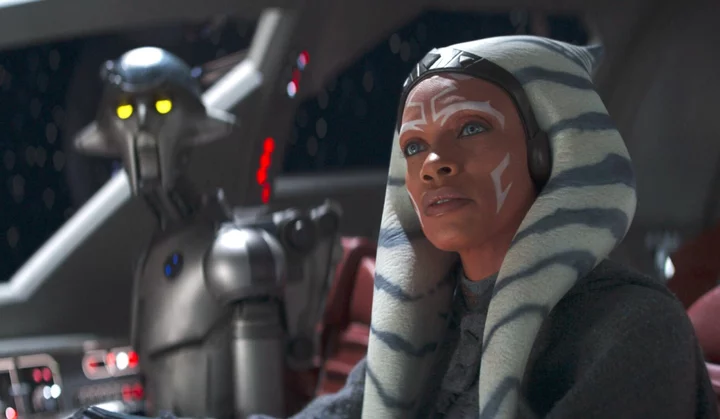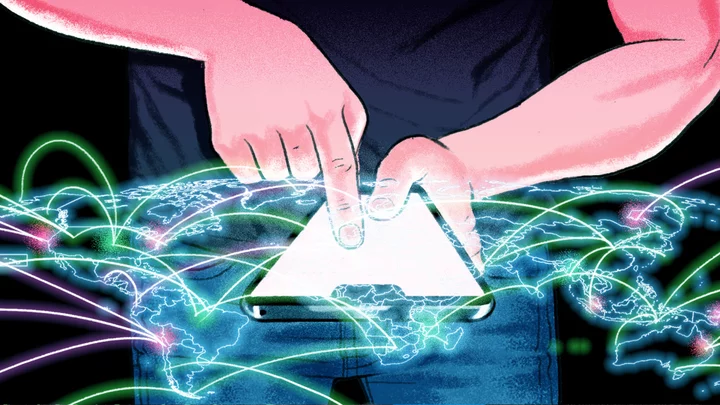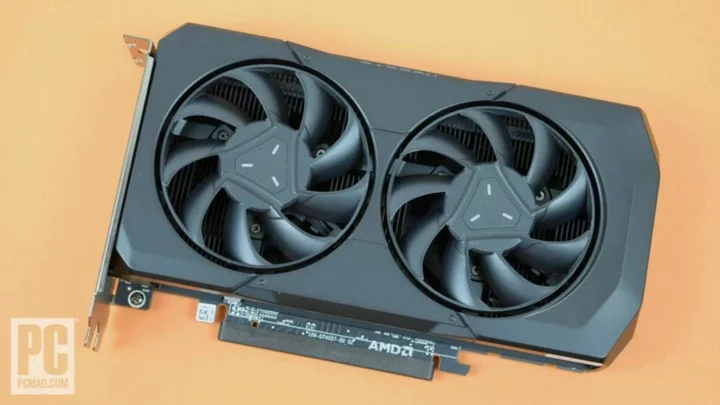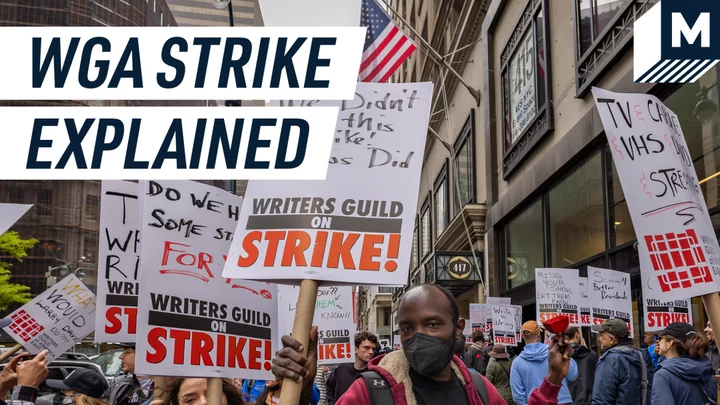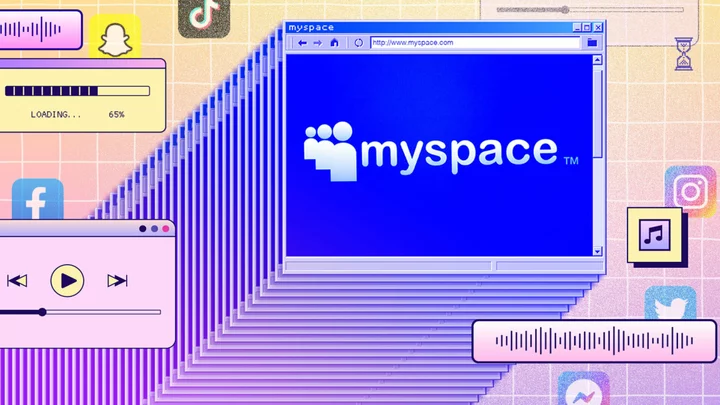This is the way Ahsoka ends: Not with a bang, but with a bunch of Easter eggs.
Trapped on the planet Peridea — which for some unnecessary reason is in a galaxy other than the one far, far away — Ahsoka Tano (Rosario Dawson) and her apprentice Sabine Wren (Natasha Liu Bordizo) see an owl. Meanwhile, former Jedi general Baylan Skoll (the late, great Ray Stevenson) has found a giant rock formation in the shape of an old man.
At this point, if you're a fan of writer-director Dave Filoni's Star Wars animation, or if you're not a fan but slogged through all seven seasons of Clone Wars and four seasons of Rebels anyway, you're pointing at the screen like the Leo diCaprio meme. That old man: It's the Father from the Mortis arc! That owl: it's Morai, a creature with some kind of spiritual attachment to Ahsoka and the Daughter from the Mortis arc, who Ahsoka may or may not have become!
But what if the planet Mortis and its mysterious god-like inhabitants mean nothing to you? What if the revelation that Peridea was the original home of the Witch Kingdom of Dathomiri leaves you cold? What if you don't head straight to Wookieepedia after every episode? What if you're a casual fan who enjoyed some, but not necessarily all, of the Star Wars movies?
Well, you'd be forgiven for feeling a little deflated by Filoni's first solo outing in live action. The cartoon guru clearly cares about making everything look right; he loves lightsaber battles and the pew-pew of set-piece space battles. (So say we all.) But does Filoni care about making his characters interesting and accessible to those who haven't seen his work yet? Has all that visual razzle-dazzle obscured the basics of storytelling? Will Ahsoka hold up in a few years, when the current excitement over Easter eggs and live-action transitions has faded?
The evidence is mixed at best, and that may be bad news for the future of the franchise.
Star Wars is story. Story is character. Character is change.
You don't have to be Joseph Campbell, maestro of the hero's journey, to understand what makes stories stick in a wide swathe of human brains. A compelling story, at its most fundamental level, is and always has been about change: characters who resist it, and characters who learn from it.
The original Star Wars is full of archetypal examples: a frustrated farm boy learns to bravely save the galaxy, not just rescue a princess; a cynical smuggler learns to care about a cause. And a mysterious mentor learns to accept his own death – the thing all human stories are really, ultimately grappling with.
The next five Star Wars movies — prequels included, whatever you think of them — delivered the tragic arc of Anakin Skywalker (Hayden Christensen). Anakin does the opposite of Obi-Wan: he fears death and wants to eradicate it. He becomes a monster as a result, more machine than man, and is ultimately redeemed by his son. Now that's epic-quality change!
Where is the character change, or the struggle against it, in Ahsoka? If you're being charitable, Ahsoka learns to stop being afraid of training Sabine as a Jedi, and Sabine learns to trust her master. But it's so unclear that Jedi-training droid Huyang (David Tennant) has to explain it to us in episode 8: telling rather than showing.
Yes, Ahsoka's master Anakin shows up in her dream, or whatever it is, in the world between worlds. And that conversation plus a random lightsaber duel (again, cool as a set-piece) seems to have some sort of effect on her, maybe?
SEE ALSO: Thrawn arrives in live-action Star Wars. Is he too late to save 'Ahsoka'?To know, the average viewer who isn't able to headcanon this stuff would have to know what exactly Ahsoka's problem was in the first place. And we don't, in part because Ahsoka has been struck by Book of Boba Fett disease: It can't focus on its supposed title character for more than an episode. Plus it wants to distract us with bright, shiny fanservice. (Hi, Threepio!)
To say that Ahsoka and Sabine do not change much is no knock on Dawson and Bordizo, who thoroughly inhabit their characters and do their best with Filoni's wooden dialogue. But they also look like best pals with only the tiniest rift between them. Ahsoka in particular seemed to be in a state of calm enlightenment throughout.
Even in her most reckless moment — flying herself and Huyang into the mouth of a space whale, with no clue where in the entire universe it will take her — there seems, from her dialogue and her expression, to be not a drop of doubt in Ahsoka's mind.
So there isn't any in ours, either: even the youngest viewer has no doubt about how this supposedly suspenseful trip will turn out. This trend of coddling characters continued through the end of the season. In its most absurd form, we're asked to believe that an entire Star Destroyer, raining "hellfire," has as poor an aim at our heroes as the average Stormtrooper.
Baylan Skoll had so much potential for drama, change, inner turmoil; we never really got to see it. How or who or what was he hoping to change with his trip to that Mortis Mount Rushmore? Sadly, with Ray Stevenson's passing, we may never get to know, at least not from Baylon's own mouth.
Morgan Elsbeth (Diana Lee Inosanto) changed! Externally, at least; she became a fully-fledged Nightsister, then sacrificed herself. Good for her, I guess? She sort of seemed to be into it? And she said "for Dathomir" under her breath, so she's kind of a patriot who isn't fully buying into Thrawn's plan? I don't know. I kept hoping there would be more for Morgan to say or do than joust and stand beside other evil characters while making fists.
Grand Admiral Thrawn (Lars Mikkelsen) was wasted with a late introduction, as I argued at the time. Still, Mikkelsen worked overtime to invest every line with silky-smooth menace, and I held out hope to the end that we'd learn just a little nugget of story about Thrawn's wilderness years. His troops had fascinating "lost Legion" vibes, squandered when they turned out to be … zombies.
What was the point of dropping them in another galaxy, exactly? What evil, mystical Dathomiri benefit did he want to bring back to the Empire's remnants? Filoni punted.
Similarly: Ezra Bridger (Eman Esfandi, radiating sheer charisma) should have gone through some sort of change in his years alone beyond learning to speak Noti, no? Practicing your Force push until you're really good at it, hugging old friends when they drop in from another galaxy, growing a nifty beard: All of these make for nice scenes in isolation, none count as character development.
Ahsoka vs. Andor
Compare and contrast with Andor, the most recent Disney+ Star Wars series. And don't come at me with "but Ahsoka is for kids" — all of Star Wars is for kids, from the start, by design, Andor included. If you don’t think good kids’ stories rely on characters who grow and change, I have a couple of Bagginses and a Gamgee to introduce you to.
Andor doesn't skimp on action sequences. It too is shot beautifully. But you don't have to settle for Star Wars that stops there! At the same time, Andor manages to be a drama of true galactic scale, one in which almost every character is compelling. Why? Because they are clearly wrestling with the pain inflicted by the Galactic Empire, and how to destroy or defend it; because we are drawn to seeing what happens next. That is, how this pain changes them.
Just one minute of the monologue above by Luthen Rael (Stellan Skarsgård, cruelly denied an Emmy nod) is enough to cast light on his inner turmoil, the dark bargain he's made. Just a few words of this sort of thing from Baylon would have worked wonders for Ahsoka.
There are many more jaw-dropping examples of Andor characters feeling the fear but doing what they think is right anyway. The official Star Wars YouTube channel also offers Maarva Andor (Fiona Shaw)'s rousing bomb-throw of a speech from beyond the grave, and Kino Loy (Andy Serkis) in one of the most effective character-change moments ever seen in Star Wars. Go on, treat yourself:
It's not that Ahsoka needed to be another Andor. Far from it! There is more than enough room in this galaxy (and apparently in others) for different kinds of narratives. You can still have a lighter whizz-bang space romp in the style of the 1930s Flash Gordon serial, the original Star Wars influence. And you can have the deep mythological feel that Filoni and Lucas both love. It's just that if you don't glue the two together with truly heroic characters — the kind who feel real, and face real trials — then the story will be as disposable as… well, the 1930s Flash Gordon serial.
Filoni and the future
Why does any of this matter? After all, judging by social media, Star Wars fandom isn't exactly having much of an internecine squabble about Ahsoka (certainly not by the standards of Star Wars fandom). Fans who don't like it are mostly keeping it to themselves and their group chats. The Clone Wars and Rebels folks are having a blast, and who wants to rain on their parade? Ahsoka ended its season at the top of the TV streaming charts. Even haters can enjoy Ahsoka, if you're resigned to just letting it wash over you as a purely visual experience.
Trouble is, this approach continues the trend we first saw in J.J. Abrams' Rise of Skywalker — which was also, lest we forget, a box office hit. Abrams has previously said he was looking for scenes that would "surprise and delight" himself as a Star Wars fan first; he'd figure out how to stitch them together later, or maybe other media would have to do that. Skywalker was a widely-panned storytelling mess as a result; the stitching stuck out all over, the changes were abrupt and weird. ("Somehow, Palpatine returned!")
If Filoni has planted himself in the Abrams storytelling camp — and his over-fondness for mystery boxes would suggest that he has — then Star Wars has bigger problems than whether or not people liked Ahsoka. The odd fanservice focus problem seen in Book of Boba Fett and the most recent season of the Mandalorian, both of which Filoni co-guided, may be a sign of the future.
Fill the episodes with lore and reference, and who cares if the story itself is any good? After all, a veritable online industry of Easter egg videos and recap posts stands poised to turn even the most mediocre tale into a Sherlock Holmes hunt.
But if you're hunting for a satisfying ending to what you just saw, you're going to be hunting a while. No Ahsoka Season 2 has been announced, let alone begun filming. Next up on Disney+ Star Wars is Skeleton Crew, the eight-part Jude Law series coming this year, likely followed by The Acolyte in 2024.
For all we know, then, the untitled, undated, Filoni-helmed movie announced at Star Wars Celebration this year may be our next encounter with the events of Ahsoka. And if Filoni has taken the lesson from Ahsoka that this is how you write characters, we could be looking at another Rise of Skywalker-style mess of flapping plot strands.
Then again, the story behind the story is still very much in play. Always in motion is the future, as Yoda said. Even if Ahsoka's character's are oddly static and 2D, there's no reason to believe that Filoni himself can't change.

